Привет!
Много людей хотели бы начать программировать на андроид, но Android Studio и Java их отпугивают. Почему? Потому, что это в некотором смысле из пушки по воробьям. «Я лишь хочу сделать змейку, и все!»

Начнем! (бонус в конце)
Плохой код
Мелкие недостатки:
- Использование «хвоста» и «головы» по отдельности. В этом нет необходимости, так как в змее голова — первая часть хвоста. Не стоит для этого всю змею делить на две части, для которых код пишется отдельно.
- Clock.schedule от self.update вызван из… self.update.
- Класс второго уровня (условно точка входа из первого класса) Playground объявлен в начале, но класс первого уровня SnakeApp объявлен в конце файла.
- Названия для направлений («up», «down», ...) вместо векторов ( (0, 1), (1, 0)… ).
Серьезные недостатки:
- Динамичные объекты (к примеру, фрукт) прикреплены к файлу kv, так что вы не можете создать более одного яблока не переписав половину кода
- Чудная логика перемещения змеи вместо клетка-за-клеткой.
- 350 строк — слишком длинный код.
Статья неочевидна для новичков
Это мое ЛИЧНОЕ мнение. Более того, я не гарантирую, что моя статья будет более интересной и понятной. Но постараюсь, а еще гарантирую:
- Код будет коротким
- Змейка красивой (относительно)
- Туториал будет иметь поэтапное развитие
Результат не комильфо
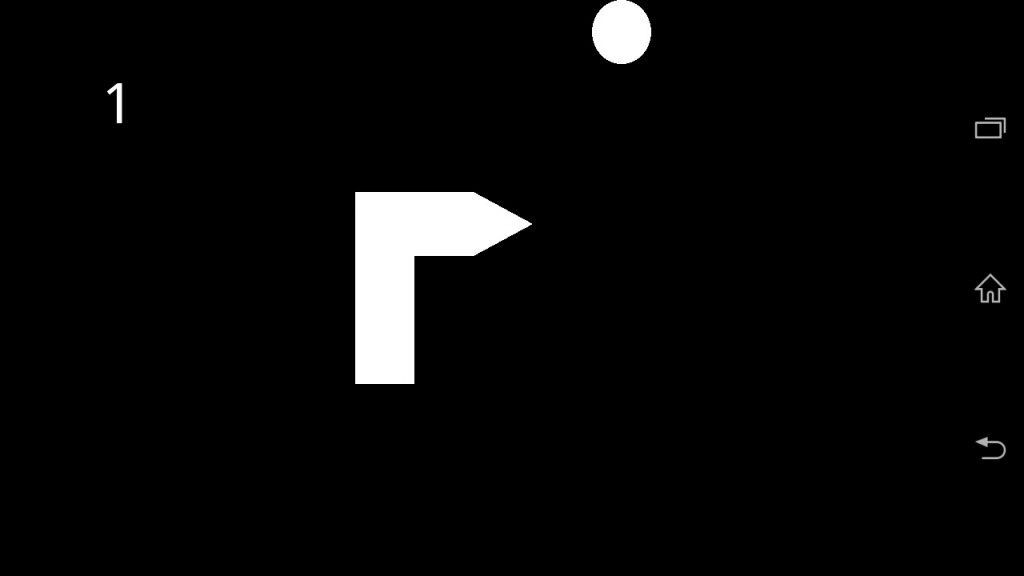
Нет расстояния между клетками, чудной треугольник, дергающаяся змейка.
Знакомство
Первое приложение
Пожалуйста, удостовертесь в том, что уже установили Kivy (если нет, следуйте инструкциям) и запустите
buildozer init в папке проекта.
Запустим первую программу:
main.py
from kivy.app import App
from kivy.uix.widget import Widget
class WormApp(App):
def build(self):
return Widget()
if __name__ == '__main__':
WormApp().run()
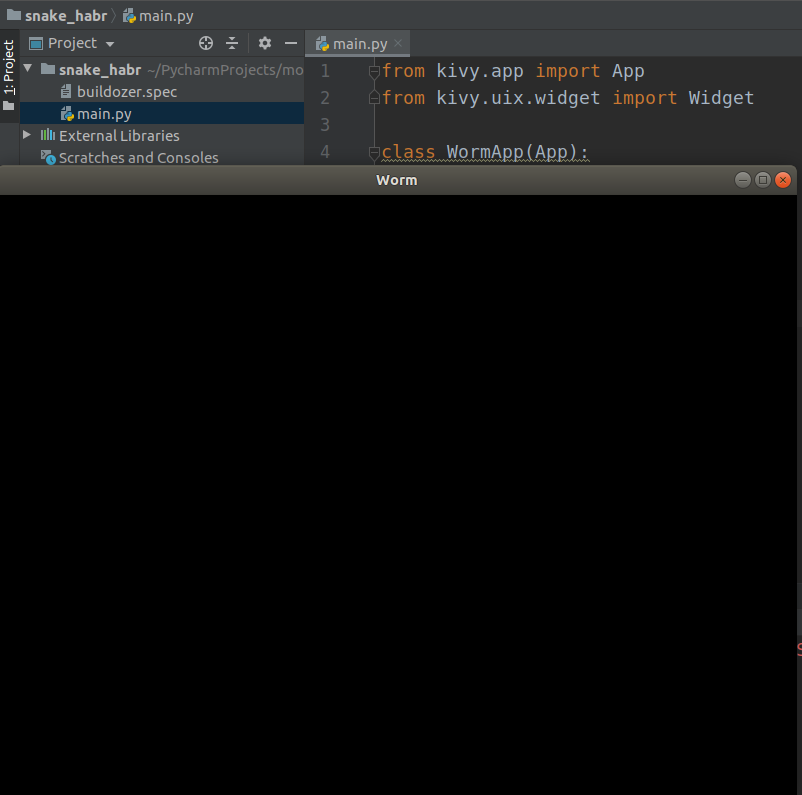
Мы создали виджет. Аналогично, мы можем создать кнопку или любой другой элемент графического интерфейса:
from kivy.app import App
from kivy.uix.widget import Widget
from kivy.uix.button import Button
class WormApp(App):
def build(self):
self.but = Button()
self.but.pos = (100, 100)
self.but.size = (200, 200)
self.but.text = "Hello, cruel world"
self.form = Widget()
self.form.add_widget(self.but)
return self.form
if __name__ == '__main__':
WormApp().run()

Ура! Поздравляю! Вы создали кнопку!
Файлы .kv
Однако, есть другой способ создавать такие элементы. Сначала объявим нашу форму:
from kivy.app import App
from kivy.uix.widget import Widget
from kivy.uix.button import Button
class Form(Widget):
def __init__(self):
super().__init__()
self.but1 = Button()
self.but1.pos = (100, 100)
self.add_widget(self.but1)
class WormApp(App):
def build(self):
self.form = Form()
return self.form
if __name__ == '__main__':
WormApp().run()
Затем создаем «worm.kv» файл.
worm.kv
<Form>:
but2: but_id
Button:
id: but_id
pos: (200, 200)
Что произошло? Мы создали еще одну кнопку и присвоим id but_id. Теперь but_id ассоциировано с but2 формы. Это означает, что мы можем обратиться к button с помощью but2:
class Form(Widget):
def __init__(self):
super().__init__()
self.but1 = Button()
self.but1.pos = (100, 100)
self.add_widget(self.but1) #
self.but2.text = "OH MY"

Графика
Далее создадим графический элемент. Сначала объявим его в worm.kv:
<Form>:
<Cell>:
canvas:
Rectangle:
size: self.size
pos: self.pos
Мы связали позицию прямоугольника с self.pos и его размер с self.size. Так что теперь эти свойства доступны из Cell, например, как только мы создаем клетку, мы можем менять ее размер и позицию:
class Cell(Widget):
def __init__(self, x, y, size):
super().__init__()
self.size = (size, size) # Как можно заметить, мы можем поменять self.size который есть свойство "size" прямоугольника
self.pos = (x, y)
class Form(Widget):
def __init__(self):
super().__init__()
self.cell = Cell(100, 100, 30)
self.add_widget(self.cell)

Окей, мы создали клетку.
Необходимые методы
Давайте попробуем двигать змею. Чтобы это сделать, мы можем добавить функцию Form.update и привязать к расписанию с помощью Clock.schedule.
from kivy.app import App
from kivy.uix.widget import Widget
from kivy.clock import Clock
class Cell(Widget):
def __init__(self, x, y, size):
super().__init__()
self.size = (size, size)
self.pos = (x, y)
class Form(Widget):
def __init__(self):
super().__init__()
self.cell = Cell(100, 100, 30)
self.add_widget(self.cell)
def start(self):
Clock.schedule_interval(self.update, 0.01)
def update(self, _):
self.cell.pos = (self.cell.pos[0] + 2, self.cell.pos[1] + 3)
class WormApp(App):
def build(self):
self.form = Form()
self.form.start()
return self.form
if __name__ == '__main__':
WormApp().run()
Клетка будет двигаться по форме. Как вы можете видеть, мы можем поставить таймер на любую функцию с помощью Clock.
Далее, создадим событие нажатия (touch event). Перепишем Form:
class Form(Widget):
def __init__(self):
super().__init__()
self.cells = []
def start(self):
Clock.schedule_interval(self.update, 0.01)
def update(self, _):
for cell in self.cells:
cell.pos = (cell.pos[0] + 2, cell.pos[1] + 3)
def on_touch_down(self, touch):
cell = Cell(touch.x, touch.y, 30)
self.add_widget(cell)
self.cells.append(cell)
Каждый touch_down создает клетку с координатами = (touch.x, touch.y) и размером = 30. Затем, мы добавим ее как виджет формы И в наш собственный массив (чтобы позднее обращаться к нему).
Теперь каждое нажатие на форму генерирует клетку.

Няшные настройки
Так как мы хотим сделать красивую змейку, мы должны логически разделить графическую и настоящую позиции.
P. S. Мы бы этим не парились если бы имели дело с on_draw. Но теперь мы не обязаны перерисовать форму лапками.
Давайте изменим файл worm.kv:
<Form>:
<Cell>:
canvas:
Rectangle:
size: self.graphical_size
pos: self.graphical_pos
и main.py:
...
from kivy.properties import *
...
class Cell(Widget):
graphical_size = ListProperty([1, 1])
graphical_pos = ListProperty([1, 1])
def __init__(self, x, y, size, margin=4):
super().__init__()
self.actual_size = (size, size)
self.graphical_size = (size - margin, size - margin)
self.margin = margin
self.actual_pos = (x, y)
self.graphical_pos_attach()
def graphical_pos_attach(self):
self.graphical_pos = (self.actual_pos[0] - self.graphical_size[0] / 2, self.actual_pos[1] - self.graphical_size[1] / 2)
...
class Form(Widget):
def __init__(self):
super().__init__()
self.cell1 = Cell(100, 100, 30)
self.cell2 = Cell(130, 100, 30)
self.add_widget(self.cell1)
self.add_widget(self.cell2)
...

Появился отступ, так что это выглядит лучше не смотря на то, что мы создали вторую клетку с X = 130 вместо 132. Позже мы будем делать мягкое передвижение, основанное на расстоянии между actual_pos и graphical_pos.
Программирование червяка
Объявление
Инициализируем config в main.py
class Config:
DEFAULT_LENGTH = 20
CELL_SIZE = 25
APPLE_SIZE = 35
MARGIN = 4
INTERVAL = 0.2
DEAD_CELL = (1, 0, 0, 1)
APPLE_COLOR = (1, 1, 0, 1)
(Поверьте, вы это полюбите!)
Затем присвойте config приложению:
class WormApp(App):
def __init__(self):
super().__init__()
self.config = Config()
self.form = Form(self.config)
def build(self):
self.form.start()
return self.form
Перепишите init и start:
class Form(Widget):
def __init__(self, config):
super().__init__()
self.config = config
self.worm = None
def start(self):
self.worm = Worm(self.config)
self.add_widget(self.worm)
Clock.schedule_interval(self.update, self.config.INTERVAL)
Затем, Cell:
class Cell(Widget):
graphical_size = ListProperty([1, 1])
graphical_pos = ListProperty([1, 1])
def __init__(self, x, y, size, margin=4):
super().__init__()
self.actual_size = (size, size)
self.graphical_size = (size - margin, size - margin)
self.margin = margin
self.actual_pos = (x, y)
self.graphical_pos_attach()
def graphical_pos_attach(self):
self.graphical_pos = (self.actual_pos[0] - self.graphical_size[0] / 2, self.actual_pos[1] - self.graphical_size[1] / 2)
def move_to(self, x, y):
self.actual_pos = (x, y)
self.graphical_pos_attach()
def move_by(self, x, y, **kwargs):
self.move_to(self.actual_pos[0] + x, self.actual_pos[1] + y, **kwargs)
def get_pos(self):
return self.actual_pos
def step_by(self, direction, **kwargs):
self.move_by(self.actual_size[0] * direction[0], self.actual_size[1] * direction[1], **kwargs)
Надеюсь, это было более менее понятно.
И наконец Worm:
class Worm(Widget):
def __init__(self, config):
super().__init__()
self.cells = []
self.config = config
self.cell_size = config.CELL_SIZE
self.head_init((100, 100))
for i in range(config.DEFAULT_LENGTH):
self.lengthen()
def destroy(self):
for i in range(len(self.cells)):
self.remove_widget(self.cells[i])
self.cells = []
def lengthen(self, pos=None, direction=(0, 1)):
# Если позиция установлена, мы перемещаем клетку туда, иначе - в соответствии с данным направлением
if pos is None:
px = self.cells[-1].get_pos()[0] + direction[0] * self.cell_size
py = self.cells[-1].get_pos()[1] + direction[1] * self.cell_size
pos = (px, py)
self.cells.append(Cell(*pos, self.cell_size, margin=self.config.MARGIN))
self.add_widget(self.cells[-1])
def head_init(self, pos):
self.lengthen(pos=pos)
Давайте создадим нашего червячка.

Движение
Теперь подвигаем ЭТО.
Тут просто:
class Worm(Widget):
...
def move(self, direction):
for i in range(len(self.cells) - 1, 0, -1):
self.cells[i].move_to(*self.cells[i - 1].get_pos())
self.cells[0].step_by(direction)
class Form(Widget):
def __init__(self, config):
super().__init__()
self.config = config
self.worm = None
self.cur_dir = (0, 0)
def start(self):
self.worm = Worm(self.config)
self.add_widget(self.worm)
self.cur_dir = (1, 0)
Clock.schedule_interval(self.update, self.config.INTERVAL)
def update(self, _):
self.worm.move(self.cur_dir)

Оно живое! Оно живое!
Управление
Как вы могли судить по первой картинке, управление змеи будет таким:
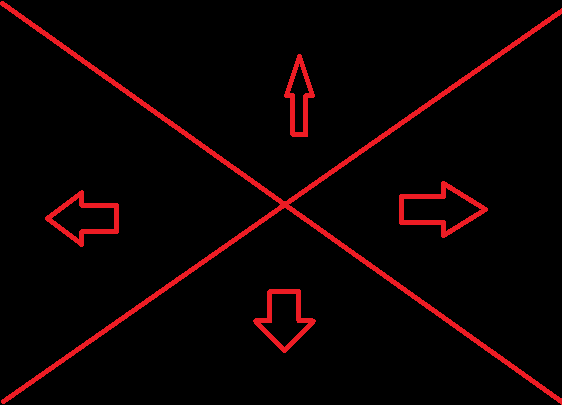
class Form(Widget):
...
def on_touch_down(self, touch):
ws = touch.x / self.size[0]
hs = touch.y / self.size[1]
aws = 1 - ws
if ws > hs and aws > hs:
cur_dir = (0, -1) # Вниз
elif ws > hs >= aws:
cur_dir = (1, 0) # Вправо
elif ws <= hs < aws:
cur_dir = (-1, 0) # Влево
else:
cur_dir = (0, 1) # Вверх
self.cur_dir = cur_dir

Здорово.
Создание фрукта
Сначала объявим.
class Form(Widget):
...
def __init__(self, config):
super().__init__()
self.config = config
self.worm = None
self.cur_dir = (0, 0)
self.fruit = None
...
def random_cell_location(self, offset):
x_row = self.size[0] // self.config.CELL_SIZE
x_col = self.size[1] // self.config.CELL_SIZE
return random.randint(offset, x_row - offset), random.randint(offset, x_col - offset)
def random_location(self, offset):
x_row, x_col = self.random_cell_location(offset)
return self.config.CELL_SIZE * x_row, self.config.CELL_SIZE * x_col
def fruit_dislocate(self):
x, y = self.random_location(2)
self.fruit.move_to(x, y)
...
def start(self):
self.fruit = Cell(0, 0, self.config.APPLE_SIZE, self.config.MARGIN)
self.worm = Worm(self.config)
self.fruit_dislocate()
self.add_widget(self.worm)
self.add_widget(self.fruit)
self.cur_dir = (1, 0)
Clock.schedule_interval(self.update, self.config.INTERVAL)
Текущий результат:
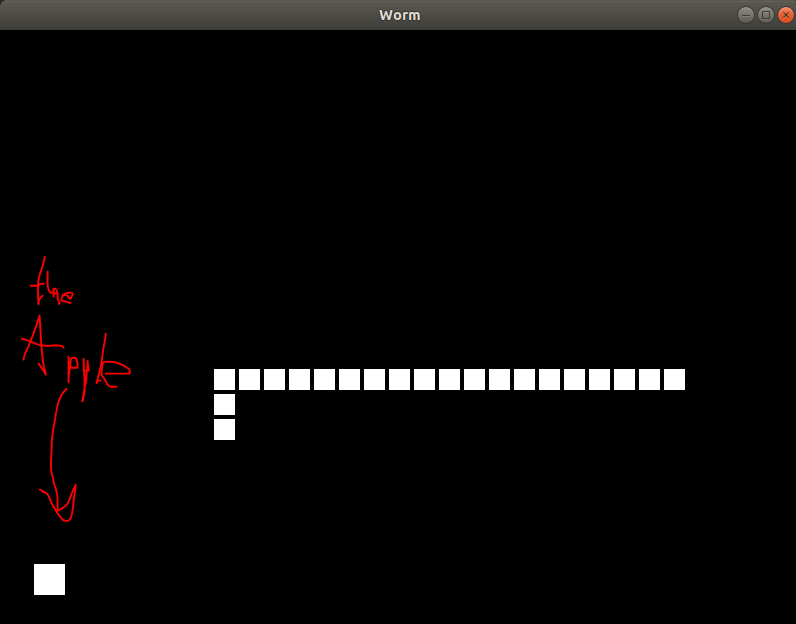
Теперь мы должны объявить несколько методов Worm:
class Worm(Widget):
...
# Тут соберем позиции всех клеток
def gather_positions(self):
return [cell.get_pos() for cell in self.cells]
# Проверка пересекается ли голова с другим объектом
def head_intersect(self, cell):
return self.cells[0].get_pos() == cell.get_pos()
class Form(Widget):
def fruit_dislocate(self):
x, y = self.random_location(2)
while (x, y) in self.worm.gather_positions():
x, y = self.random_location(2)
self.fruit.move_to(x, y)
На этот моменте позиция яблока не сможет совпадать с позиции хвоста
… и добавим проверку в update()
class Form(Widget):
...
def update(self, _):
self.worm.move(self.cur_dir)
if self.worm.head_intersect(self.fruit):
directions = [(0, 1), (0, -1), (1, 0), (-1, 0)]
self.worm.lengthen(direction=random.choice(directions))
self.fruit_dislocate()
Определение пересечения головы и хвоста
Мы хотим узнать та же ли позиция у головы, что у какой-то клетки хвоста.
class Form(Widget):
...
def __init__(self, config):
super().__init__()
self.config = config
self.worm = None
self.cur_dir = (0, 0)
self.fruit = None
self.game_on = True
def update(self, _):
if not self.game_on:
return
self.worm.move(self.cur_dir)
if self.worm.head_intersect(self.fruit):
directions = [(0, 1), (0, -1), (1, 0), (-1, 0)]
self.worm.lengthen(direction=random.choice(directions))
self.fruit_dislocate()
if self.worm_bite_self():
self.game_on = False
def worm_bite_self(self):
for cell in self.worm.cells[1:]:
if self.worm.head_intersect(cell):
return cell
return False

Раскрашивание, декорирование, рефакторинг кода
Начнем с рефакторинга.
Перепишем и добавим
class Form(Widget):
...
def start(self):
self.worm = Worm(self.config)
self.add_widget(self.worm)
if self.fruit is not None:
self.remove_widget(self.fruit)
self.fruit = Cell(0, 0, self.config.APPLE_SIZE)
self.fruit_dislocate()
self.add_widget(self.fruit)
Clock.schedule_interval(self.update, self.config.INTERVAL)
self.game_on = True
self.cur_dir = (0, -1)
def stop(self):
self.game_on = False
Clock.unschedule(self.update)
def game_over(self):
self.stop()
...
def on_touch_down(self, touch):
if not self.game_on:
self.worm.destroy()
self.start()
return
...
Теперь если червяк мертв (заморожен), если вы нажмете на экран, игра будет начата заново.
Теперь перейдим к декорированию и раскрашиванию.
worm.kv
<Form>:
popup_label: popup_label
score_label: score_label
canvas:
Color:
rgba: (.5, .5, .5, 1.0)
Line:
width: 1.5
points: (0, 0), self.size
Line:
width: 1.5
points: (self.size[0], 0), (0, self.size[1])
Label:
id: score_label
text: "Score: " + str(self.parent.worm_len)
width: self.width
Label:
id: popup_label
width: self.width
<Worm>:
<Cell>:
canvas:
Color:
rgba: self.color
Rectangle:
size: self.graphical_size
pos: self.graphical_pos
Перепишем WormApp:
class WormApp(App):
def build(self):
self.config = Config()
self.form = Form(self.config)
return self.form
def on_start(self):
self.form.start()
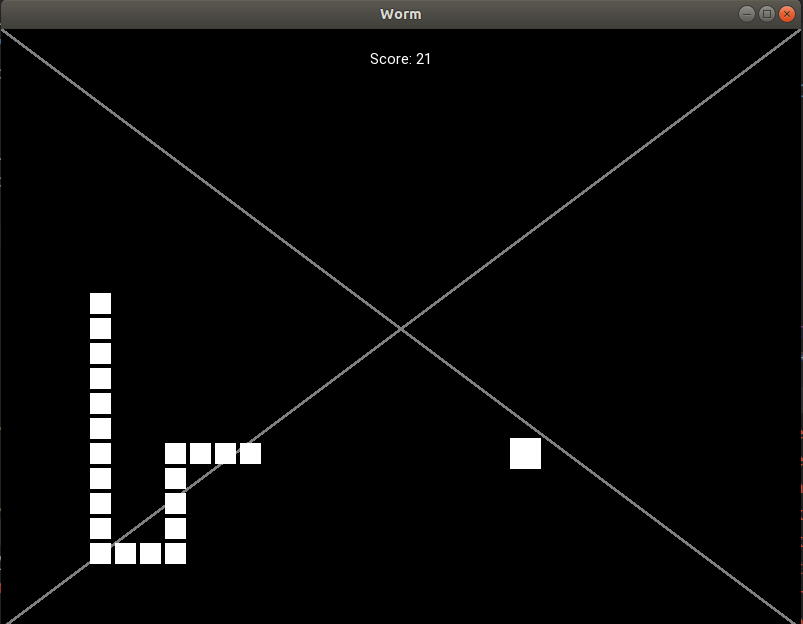
Раскрасим. Перепишем Cell in .kv:
<Cell>:
canvas:
Color:
rgba: self.color
Rectangle:
size: self.graphical_size
pos: self.graphical_pos
Добавим это к Cell.__init__:
self.color = (0.2, 1.0, 0.2, 1.0) #
и это к Form.start
self.fruit.color = (1.0, 0.2, 0.2, 1.0)
Превосходно, наслаждайтесь змейкой

Наконец, мы создадим надпись «game over»
class Form(Widget):
...
def __init__(self, config):
...
self.popup_label.text = ""
...
def stop(self, text=""):
self.game_on = False
self.popup_label.text = text
Clock.unschedule(self.update)
def game_over(self):
self.stop("GAME OVER" + " " * 5 + "ntap to reset")
И зададим «раненой» клетке красный цвет:
вместо
def update(self, _):
...
if self.worm_bite_self():
self.game_over()
...
напишите
def update(self, _):
cell = self.worm_bite_self()
if cell:
cell.color = (1.0, 0.2, 0.2, 1.0)
self.game_over()

Вы еще тут? Самая интересная часть впереди!
Бонус — плавное движение
Так как шаг червячка равен cell_size, выглядит не очень плавно. Но мы бы хотели шагать как можно чаще без полного переписывания логики игры. Таким образом, нам нужен механизм, который двигал бы наши графические позиции (graphical_pos) но не влиял бы на настоящие (actual_pos). Я написал следующий код:
smooth.py
from kivy.clock import Clock
import time
class Timing:
@staticmethod
def linear(x):
return x
class Smooth:
def __init__(self, interval=1.0/60.0):
self.objs = []
self.running = False
self.interval = interval
def run(self):
if self.running:
return
self.running = True
Clock.schedule_interval(self.update, self.interval)
def stop(self):
if not self.running:
return
self.running = False
Clock.unschedule(self.update)
def setattr(self, obj, attr, value):
exec("obj." + attr + " = " + str(value))
def getattr(self, obj, attr):
return float(eval("obj." + attr))
def update(self, _):
cur_time = time.time()
for line in self.objs:
obj, prop_name_x, prop_name_y, from_x, from_y, to_x, to_y, start_time, period, timing = line
time_gone = cur_time - start_time
if time_gone >= period:
self.setattr(obj, prop_name_x, to_x)
self.setattr(obj, prop_name_y, to_y)
self.objs.remove(line)
else:
share = time_gone / period
acs = timing(share)
self.setattr(obj, prop_name_x, from_x * (1 - acs) + to_x * acs)
self.setattr(obj, prop_name_y, from_y * (1 - acs) + to_y * acs)
if len(self.objs) == 0:
self.stop()
def move_to(self, obj, prop_name_x, prop_name_y, to_x, to_y, t, timing=Timing.linear):
self.objs.append((obj, prop_name_x, prop_name_y, self.getattr(obj, prop_name_x), self.getattr(obj, prop_name_y), to_x,
to_y, time.time(), t, timing))
self.run()
class XSmooth(Smooth):
def __init__(self, props, timing=Timing.linear, *args, **kwargs):
super().__init__(*args, **kwargs)
self.props = props
self.timing = timing
def move_to(self, obj, to_x, to_y, t):
super().move_to(obj, *self.props, to_x, to_y, t, timing=self.timing)
Так, вы лишь создаете smooth.py and и копируете код в файл.
Наконец, заставим ЭТО работать!
class Form(Widget):
...
def __init__(self, config):
...
self.smooth = smooth.XSmooth(["graphical_pos[0]", "graphical_pos[1]"])
Заменим self.worm.move() с
class Form(Widget):
...
def update(self, _):
...
self.worm.move(self.cur_dir, smooth_motion=(self.smooth, self.config.INTERVAL))
А это как методы Cell должны выглядить
class Cell(Widget):
...
def graphical_pos_attach(self, smooth_motion=None):
to_x, to_y = self.actual_pos[0] - self.graphical_size[0] / 2, self.actual_pos[1] - self.graphical_size[1] / 2
if smooth_motion is None:
self.graphical_pos = to_x, to_y
else:
smoother, t = smooth_motion
smoother.move_to(self, to_x, to_y, t)
def move_to(self, x, y, **kwargs):
self.actual_pos = (x, y)
self.graphical_pos_attach(**kwargs)
def move_by(self, x, y, **kwargs):
self.move_to(self.actual_pos[0] + x, self.actual_pos[1] + y, **kwargs)
Ну вот и все, спасибо за ваше внимание! Код снизу.
Демонстрационное видео как работает результат:
from kivy.app import App
from kivy.uix.widget import Widget
from kivy.clock import Clock
from kivy.properties import *
import random
import smooth
class Cell(Widget):
graphical_size = ListProperty([1, 1])
graphical_pos = ListProperty([1, 1])
color = ListProperty([1, 1, 1, 1])
def __init__(self, x, y, size, margin=4):
super().__init__()
self.actual_size = (size, size)
self.graphical_size = (size - margin, size - margin)
self.margin = margin
self.actual_pos = (x, y)
self.graphical_pos_attach()
self.color = (0.2, 1.0, 0.2, 1.0)
def graphical_pos_attach(self, smooth_motion=None):
to_x, to_y = self.actual_pos[0] - self.graphical_size[0] / 2, self.actual_pos[1] - self.graphical_size[1] / 2
if smooth_motion is None:
self.graphical_pos = to_x, to_y
else:
smoother, t = smooth_motion
smoother.move_to(self, to_x, to_y, t)
def move_to(self, x, y, **kwargs):
self.actual_pos = (x, y)
self.graphical_pos_attach(**kwargs)
def move_by(self, x, y, **kwargs):
self.move_to(self.actual_pos[0] + x, self.actual_pos[1] + y, **kwargs)
def get_pos(self):
return self.actual_pos
def step_by(self, direction, **kwargs):
self.move_by(self.actual_size[0] * direction[0], self.actual_size[1] * direction[1], **kwargs)
class Worm(Widget):
def __init__(self, config):
super().__init__()
self.cells = []
self.config = config
self.cell_size = config.CELL_SIZE
self.head_init((100, 100))
for i in range(config.DEFAULT_LENGTH):
self.lengthen()
def destroy(self):
for i in range(len(self.cells)):
self.remove_widget(self.cells[i])
self.cells = []
def lengthen(self, pos=None, direction=(0, 1)):
if pos is None:
px = self.cells[-1].get_pos()[0] + direction[0] * self.cell_size
py = self.cells[-1].get_pos()[1] + direction[1] * self.cell_size
pos = (px, py)
self.cells.append(Cell(*pos, self.cell_size, margin=self.config.MARGIN))
self.add_widget(self.cells[-1])
def head_init(self, pos):
self.lengthen(pos=pos)
def move(self, direction, **kwargs):
for i in range(len(self.cells) - 1, 0, -1):
self.cells[i].move_to(*self.cells[i - 1].get_pos(), **kwargs)
self.cells[0].step_by(direction, **kwargs)
def gather_positions(self):
return [cell.get_pos() for cell in self.cells]
def head_intersect(self, cell):
return self.cells[0].get_pos() == cell.get_pos()
class Form(Widget):
worm_len = NumericProperty(0)
def __init__(self, config):
super().__init__()
self.config = config
self.worm = None
self.cur_dir = (0, 0)
self.fruit = None
self.game_on = True
self.smooth = smooth.XSmooth(["graphical_pos[0]", "graphical_pos[1]"])
def random_cell_location(self, offset):
x_row = self.size[0] // self.config.CELL_SIZE
x_col = self.size[1] // self.config.CELL_SIZE
return random.randint(offset, x_row - offset), random.randint(offset, x_col - offset)
def random_location(self, offset):
x_row, x_col = self.random_cell_location(offset)
return self.config.CELL_SIZE * x_row, self.config.CELL_SIZE * x_col
def fruit_dislocate(self):
x, y = self.random_location(2)
while (x, y) in self.worm.gather_positions():
x, y = self.random_location(2)
self.fruit.move_to(x, y)
def start(self):
self.worm = Worm(self.config)
self.add_widget(self.worm)
if self.fruit is not None:
self.remove_widget(self.fruit)
self.fruit = Cell(0, 0, self.config.APPLE_SIZE)
self.fruit.color = (1.0, 0.2, 0.2, 1.0)
self.fruit_dislocate()
self.add_widget(self.fruit)
self.game_on = True
self.cur_dir = (0, -1)
Clock.schedule_interval(self.update, self.config.INTERVAL)
self.popup_label.text = ""
def stop(self, text=""):
self.game_on = False
self.popup_label.text = text
Clock.unschedule(self.update)
def game_over(self):
self.stop("GAME OVER" + " " * 5 + "ntap to reset")
def align_labels(self):
try:
self.popup_label.pos = ((self.size[0] - self.popup_label.width) / 2, self.size[1] / 2)
self.score_label.pos = ((self.size[0] - self.score_label.width) / 2, self.size[1] - 80)
except:
print(self.__dict__)
assert False
def update(self, _):
if not self.game_on:
return
self.worm.move(self.cur_dir, smooth_motion=(self.smooth, self.config.INTERVAL))
if self.worm.head_intersect(self.fruit):
directions = [(0, 1), (0, -1), (1, 0), (-1, 0)]
self.worm.lengthen(direction=random.choice(directions))
self.fruit_dislocate()
cell = self.worm_bite_self()
if cell:
cell.color = (1.0, 0.2, 0.2, 1.0)
self.game_over()
self.worm_len = len(self.worm.cells)
self.align_labels()
def on_touch_down(self, touch):
if not self.game_on:
self.worm.destroy()
self.start()
return
ws = touch.x / self.size[0]
hs = touch.y / self.size[1]
aws = 1 - ws
if ws > hs and aws > hs:
cur_dir = (0, -1)
elif ws > hs >= aws:
cur_dir = (1, 0)
elif ws <= hs < aws:
cur_dir = (-1, 0)
else:
cur_dir = (0, 1)
self.cur_dir = cur_dir
def worm_bite_self(self):
for cell in self.worm.cells[1:]:
if self.worm.head_intersect(cell):
return cell
return False
class Config:
DEFAULT_LENGTH = 20
CELL_SIZE = 25
APPLE_SIZE = 35
MARGIN = 4
INTERVAL = 0.3
DEAD_CELL = (1, 0, 0, 1)
APPLE_COLOR = (1, 1, 0, 1)
class WormApp(App):
def build(self):
self.config = Config()
self.form = Form(self.config)
return self.form
def on_start(self):
self.form.start()
if __name__ == '__main__':
WormApp().run()
from kivy.clock import Clock
import time
class Timing:
@staticmethod
def linear(x):
return x
class Smooth:
def __init__(self, interval=1.0/60.0):
self.objs = []
self.running = False
self.interval = interval
def run(self):
if self.running:
return
self.running = True
Clock.schedule_interval(self.update, self.interval)
def stop(self):
if not self.running:
return
self.running = False
Clock.unschedule(self.update)
def setattr(self, obj, attr, value):
exec("obj." + attr + " = " + str(value))
def getattr(self, obj, attr):
return float(eval("obj." + attr))
def update(self, _):
cur_time = time.time()
for line in self.objs:
obj, prop_name_x, prop_name_y, from_x, from_y, to_x, to_y, start_time, period, timing = line
time_gone = cur_time - start_time
if time_gone >= period:
self.setattr(obj, prop_name_x, to_x)
self.setattr(obj, prop_name_y, to_y)
self.objs.remove(line)
else:
share = time_gone / period
acs = timing(share)
self.setattr(obj, prop_name_x, from_x * (1 - acs) + to_x * acs)
self.setattr(obj, prop_name_y, from_y * (1 - acs) + to_y * acs)
if len(self.objs) == 0:
self.stop()
def move_to(self, obj, prop_name_x, prop_name_y, to_x, to_y, t, timing=Timing.linear):
self.objs.append((obj, prop_name_x, prop_name_y, self.getattr(obj, prop_name_x), self.getattr(obj, prop_name_y), to_x,
to_y, time.time(), t, timing))
self.run()
class XSmooth(Smooth):
def __init__(self, props, timing=Timing.linear, *args, **kwargs):
super().__init__(*args, **kwargs)
self.props = props
self.timing = timing
def move_to(self, obj, to_x, to_y, t):
super().move_to(obj, *self.props, to_x, to_y, t, timing=self.timing)
<Form>:
popup_label: popup_label
score_label: score_label
canvas:
Color:
rgba: (.5, .5, .5, 1.0)
Line:
width: 1.5
points: (0, 0), self.size
Line:
width: 1.5
points: (self.size[0], 0), (0, self.size[1])
Label:
id: score_label
text: "Score: " + str(self.parent.worm_len)
width: self.width
Label:
id: popup_label
width: self.width
<Worm>:
<Cell>:
canvas:
Color:
rgba: self.color
Rectangle:
size: self.graphical_size
pos: self.graphical_pos
from kivy.app import App
from kivy.uix.widget import Widget
from kivy.clock import Clock
from kivy.properties import *
import random
import smooth
class Cell:
def __init__(self, x, y):
self.actual_pos = (x, y)
def move_to(self, x, y):
self.actual_pos = (x, y)
def move_by(self, x, y):
self.move_to(self.actual_pos[0] + x, self.actual_pos[1] + y)
def get_pos(self):
return self.actual_pos
class Fruit(Cell):
def __init__(self, x, y):
super().__init__(x, y)
class Worm(Widget):
margin = NumericProperty(4)
graphical_poses = ListProperty()
inj_pos = ListProperty([-1000, -1000])
graphical_size = NumericProperty(0)
def __init__(self, config, **kwargs):
super().__init__(**kwargs)
self.cells = []
self.config = config
self.cell_size = config.CELL_SIZE
self.head_init((self.config.CELL_SIZE * random.randint(3, 5), self.config.CELL_SIZE * random.randint(3, 5)))
self.margin = config.MARGIN
self.graphical_size = self.cell_size - self.margin
for i in range(config.DEFAULT_LENGTH):
self.lengthen()
def destroy(self):
self.cells = []
self.graphical_poses = []
self.inj_pos = [-1000, -1000]
def cell_append(self, pos):
self.cells.append(Cell(*pos))
self.graphical_poses.extend([0, 0])
self.cell_move_to(len(self.cells) - 1, pos)
def lengthen(self, pos=None, direction=(0, 1)):
if pos is None:
px = self.cells[-1].get_pos()[0] + direction[0] * self.cell_size
py = self.cells[-1].get_pos()[1] + direction[1] * self.cell_size
pos = (px, py)
self.cell_append(pos)
def head_init(self, pos):
self.lengthen(pos=pos)
def cell_move_to(self, i, pos, smooth_motion=None):
self.cells[i].move_to(*pos)
to_x, to_y = pos[0], pos[1]
if smooth_motion is None:
self.graphical_poses[i * 2], self.graphical_poses[i * 2 + 1] = to_x, to_y
else:
smoother, t = smooth_motion
smoother.move_to(self, "graphical_poses[" + str(i * 2) + "]", "graphical_poses[" + str(i * 2 + 1) + "]",
to_x, to_y, t)
def move(self, direction, **kwargs):
for i in range(len(self.cells) - 1, 0, -1):
self.cell_move_to(i, self.cells[i - 1].get_pos(), **kwargs)
self.cell_move_to(0, (self.cells[0].get_pos()[0] + self.cell_size * direction[0], self.cells[0].get_pos()[1] +
self.cell_size * direction[1]), **kwargs)
def gather_positions(self):
return [cell.get_pos() for cell in self.cells]
def head_intersect(self, cell):
return self.cells[0].get_pos() == cell.get_pos()
class Form(Widget):
worm_len = NumericProperty(0)
fruit_pos = ListProperty([0, 0])
fruit_size = NumericProperty(0)
def __init__(self, config, **kwargs):
super().__init__(**kwargs)
self.config = config
self.worm = None
self.cur_dir = (0, 0)
self.fruit = None
self.game_on = True
self.smooth = smooth.Smooth()
def random_cell_location(self, offset):
x_row = self.size[0] // self.config.CELL_SIZE
x_col = self.size[1] // self.config.CELL_SIZE
return random.randint(offset, x_row - offset), random.randint(offset, x_col - offset)
def random_location(self, offset):
x_row, x_col = self.random_cell_location(offset)
return self.config.CELL_SIZE * x_row, self.config.CELL_SIZE * x_col
def fruit_dislocate(self, xy=None):
if xy is not None:
x, y = xy
else:
x, y = self.random_location(2)
while (x, y) in self.worm.gather_positions():
x, y = self.random_location(2)
self.fruit.move_to(x, y)
self.fruit_pos = (x, y)
def start(self):
self.worm = Worm(self.config)
self.add_widget(self.worm)
self.fruit = Fruit(0, 0)
self.fruit_size = self.config.APPLE_SIZE
self.fruit_dislocate()
self.game_on = True
self.cur_dir = (0, -1)
Clock.schedule_interval(self.update, self.config.INTERVAL)
self.popup_label.text = ""
def stop(self, text=""):
self.game_on = False
self.popup_label.text = text
Clock.unschedule(self.update)
def game_over(self):
self.stop("GAME OVER" + " " * 5 + "ntap to reset")
def align_labels(self):
self.popup_label.pos = ((self.size[0] - self.popup_label.width) / 2, self.size[1] / 2)
self.score_label.pos = ((self.size[0] - self.score_label.width) / 2, self.size[1] - 80)
def update(self, _):
if not self.game_on:
return
self.worm.move(self.cur_dir, smooth_motion=(self.smooth, self.config.INTERVAL))
if self.worm.head_intersect(self.fruit):
directions = [(0, 1), (0, -1), (1, 0), (-1, 0)]
self.worm.lengthen(direction=random.choice(directions))
self.fruit_dislocate()
cell = self.worm_bite_self()
if cell is not None:
self.worm.inj_pos = cell.get_pos()
self.game_over()
self.worm_len = len(self.worm.cells)
self.align_labels()
def on_touch_down(self, touch):
if not self.game_on:
self.worm.destroy()
self.start()
return
ws = touch.x / self.size[0]
hs = touch.y / self.size[1]
aws = 1 - ws
if ws > hs and aws > hs:
cur_dir = (0, -1)
elif ws > hs >= aws:
cur_dir = (1, 0)
elif ws <= hs < aws:
cur_dir = (-1, 0)
else:
cur_dir = (0, 1)
self.cur_dir = cur_dir
def worm_bite_self(self):
for cell in self.worm.cells[1:]:
if self.worm.head_intersect(cell):
return cell
return None
class Config:
DEFAULT_LENGTH = 20
CELL_SIZE = 26 # НЕ ЗАБУДЬТЕ, ЧТО CELL_SIZE - MARGIN ДОЛЖНО ДЕЛИТЬСЯ НА 4
APPLE_SIZE = 36
MARGIN = 2
INTERVAL = 0.3
DEAD_CELL = (1, 0, 0, 1)
APPLE_COLOR = (1, 1, 0, 1)
class WormApp(App):
def __init__(self, **kwargs):
super().__init__(**kwargs)
self.form = None
def build(self, **kwargs):
self.config = Config()
self.form = Form(self.config, **kwargs)
return self.form
def on_start(self):
self.form.start()
if __name__ == '__main__':
WormApp().run()
from kivy.clock import Clock
import time
class Timing:
@staticmethod
def linear(x):
return x
class Smooth:
def __init__(self, interval=1.0/60.0):
self.objs = []
self.running = False
self.interval = interval
def run(self):
if self.running:
return
self.running = True
Clock.schedule_interval(self.update, self.interval)
def stop(self):
if not self.running:
return
self.running = False
Clock.unschedule(self.update)
def set_attr(self, obj, attr, value):
exec("obj." + attr + " = " + str(value))
def get_attr(self, obj, attr):
return float(eval("obj." + attr))
def update(self, _):
cur_time = time.time()
for line in self.objs:
obj, prop_name_x, prop_name_y, from_x, from_y, to_x, to_y, start_time, period, timing = line
time_gone = cur_time - start_time
if time_gone >= period:
self.set_attr(obj, prop_name_x, to_x)
self.set_attr(obj, prop_name_y, to_y)
self.objs.remove(line)
else:
share = time_gone / period
acs = timing(share)
self.set_attr(obj, prop_name_x, from_x * (1 - acs) + to_x * acs)
self.set_attr(obj, prop_name_y, from_y * (1 - acs) + to_y * acs)
if len(self.objs) == 0:
self.stop()
def move_to(self, obj, prop_name_x, prop_name_y, to_x, to_y, t, timing=Timing.linear):
self.objs.append((obj, prop_name_x, prop_name_y, self.get_attr(obj, prop_name_x), self.get_attr(obj, prop_name_y), to_x,
to_y, time.time(), t, timing))
self.run()
class XSmooth(Smooth):
def __init__(self, props, timing=Timing.linear, *args, **kwargs):
super().__init__(*args, **kwargs)
self.props = props
self.timing = timing
def move_to(self, obj, to_x, to_y, t):
super().move_to(obj, *self.props, to_x, to_y, t, timing=self.timing)
<Form>:
popup_label: popup_label
score_label: score_label
canvas:
Color:
rgba: (.5, .5, .5, 1.0)
Line:
width: 1.5
points: (0, 0), self.size
Line:
width: 1.5
points: (self.size[0], 0), (0, self.size[1])
Color:
rgba: (1.0, 0.2, 0.2, 1.0)
Point:
points: self.fruit_pos
pointsize: self.fruit_size / 2
Label:
id: score_label
text: "Score: " + str(self.parent.worm_len)
width: self.width
Label:
id: popup_label
width: self.width
<Worm>:
canvas:
Color:
rgba: (0.2, 1.0, 0.2, 1.0)
Point:
points: self.graphical_poses
pointsize: self.graphical_size / 2
Color:
rgba: (1.0, 0.2, 0.2, 1.0)
Point:
points: self.inj_pos
pointsize: self.graphical_size / 2
Задавайте любые вопросы.
Автор: WhiteBlackGoose






